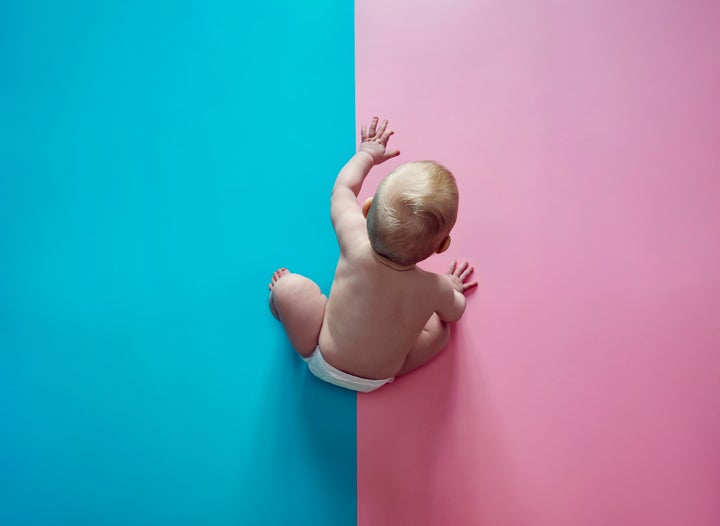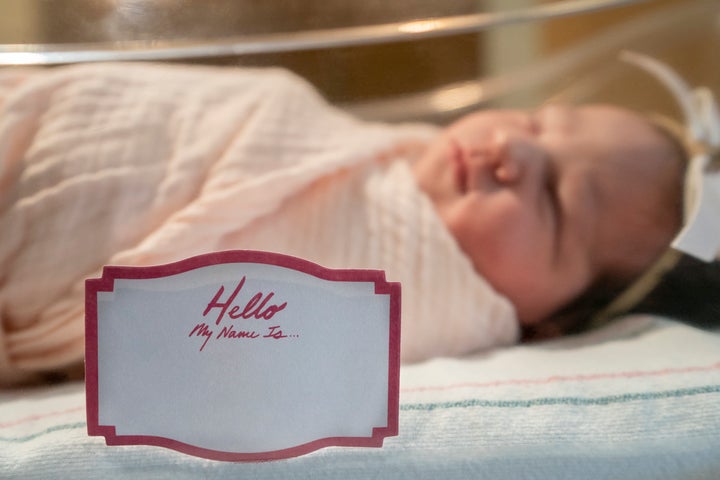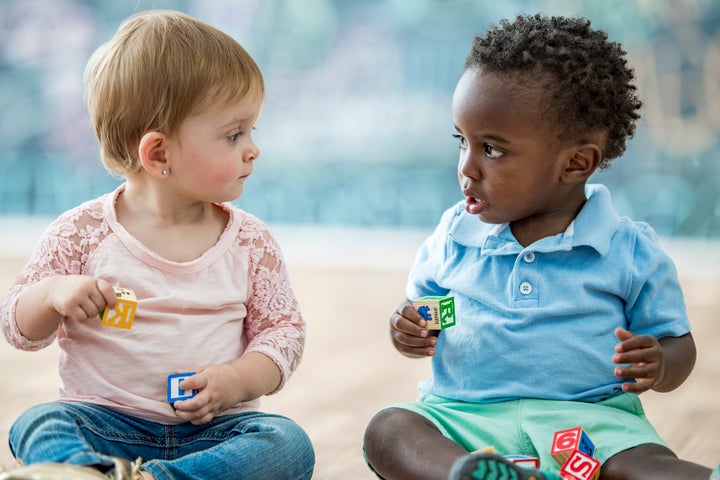
The world of baby naming is filled with surprising trends and phenomena, particularly around gender.
Looking at the baby announcements on social media, it seems that parents are more willing to choose modern or unconventional names for their daughters, while sticking to traditional picks for their sons.
The data supports this impression. The US Social Security Administration documents all names given to five or more baby boys or girls born in a given year. In 2021, there were 17,544 names for girls and 13,993 for boys. And while 357,528 newborn girls were given one of the top 50 names in the US, an even greater 448,869 boys got a top 50 name.
“For generations, we often passed down a handful of traditional favourites to our sons,” Abby Sandel, creator of the baby name blog Appellation Mountain, tells HuffPost.
Going back to the 1880s, the names William, Joseph, John and James have never fallen from the SSA’s top 30 names in the US. The only girl’s name with that kind of endurance, Sandel noted, is Elizabeth.
“American parents have tended to name boys after their fathers and grandfathers ― helped, of course, by how timeless many of those classics feel,” Sandel explains. “Naming your son after grandpa Charles is an easier sell than naming a daughter after grandma Brenda.”
While Charles remains on the top 50 list to this day, the once-fashionable name Brenda has dropped off the top 1,000 ― reflecting the higher turnover in trendy names for girls as parents try out newer options.
And it’s not just unconventional names that parents of daughters are more likely to embrace; American parents show more willingness to experiment with different spellings for their daughters’ names as well.
“There’s a single spelling of Matthew in the US top 500, compared to five versions of Madeline,” Sandel says.
So why the contrast in approaches to boy and girl names? As with all complex social phenomena, there are many factors at play and potential reasons.
We asked experts in baby names, sociology, gender studies, psychology to share why they believe parents are more experimental with their daughters’ names than with their sons’.
The ‘playground effect’
“Despite lots of progress, we still have a narrower definition of what’s acceptably masculine,” Sandel says. “Even now, parents will sheepishly admit that they worry about their boys being teased for having an unconventional name.”
This so-called playground effect has been a factor in parents’ baby-naming decisions for decades. Basically, they ask: will this name be weaponised by bullies at breaktime? That fear seems to be stronger around sons.

“It seems counterintuitive, given that sexism is still a serious problem, but women tend to have more leeway with testing some gender boundaries in our society than men do,” says Margaret Betz, an assistant teaching professor in philosophy and a member of the gender studies faculty at Rutgers University.
“For instance, it would be considered sexy for a woman to put on a tie and suit jacket – traditionally men’s clothes – but the same doesn’t currently hold for a man to wear a skirt or high heels.”
Although some male-identifying celebrities sport the occasional skirt or gown on the red carpet, these moments have sparked discussion – and even outrage in some circles.
“Baby names are another expression of this: I have two sons and gave them both typically masculine names,” Betz explains. “I’ve noticed recent trends where parents choose these same names for their daughters. But the trends don’t hold for parents choosing very feminine names (say, Tiffany) for their sons.”
“Over time, as more girls are given a name that used to be coded as a boy’s name, parents may stop using it for boys. That reduces the variety of names parents feel comfortable choosing for boys.”
- Gwen Sharp
There’s data supporting this phenomenon as well. The SSA archives reveal that traditionally male names tend to tank in popularity for boys as they become more popular for girls. Past examples include Whitney, Ashley, Blair, Leslie and Dana.
“We often see parents adopting what was a boys’ name and giving it to daughters. It’s a way to make your daughter seem a little bit cool or unusual,” says Gwen Sharp, a sociology professor and vice provost for academic initiatives and strategy at Nevada State College.
“Over time, as more girls are given a name that used to be coded as a boy’s name, parents may stop using it for boys. That reduces the variety of names parents feel comfortable choosing for boys.”
Indeed, you don’t see many parents pushing boundaries by giving their sons traditionally female names like Jennifer or inventing new names entirely, a la Gwyneth Paltrow and Chris Martin’s daughter Apple. (Notably, the former pair opted for a more traditional choice, Moses, for their son.) The popular baby naming website Nameberry’s list of “invented baby names” consists of 82 options for girls, but only half as many for boys.
“Often, experimental names are gender ambiguous, and prior research by the late sociologist Stanley Lieberson shows that parents are much more gender fluid in naming daughters,” says Dalton Conley, a professor of sociology at Princeton University. “For example, names always flow from male to gender neutral to female – never the reverse flow.”
Even in this day and age, males are unfortunately held to more rigid gender standards in clothing, names and other elements of identity. So, while girls can adopt aspects of masculinity without drawing much attention, society still looks less favourably on boys exploring femininity.
“I think to best understand this apparent freedom to test gender norms with girls and women, we have to look at what gender roles represent in our society,” Betz explains. “Men and their characteristics have been considered superior for most of history.”
This explains why we tend to view men as “natural leaders,” but not women, and why women-associated traits like ease in expressing emotions can be seen as “weakness.”
“Given all that, we subtly understand why girls and women would want to model themselves after what is considered ‘better’ – male characteristics or clothes or even names,” Betz says.
“Masculine-sounding names give girls and women an air of respectability and authority. In contrast, because we think of things associated with girls and women to be weaker and inferior, when men choose to act ‘feminine,’ we think it’s beneath them.”
The namesake tradition
A simpler reason for the smaller number of documented names for boys is the tradition of naming sons after their fathers
“Historically, baby boys were given names that established family ties as a way to carry on family legacy or ensure future inheritance,” says Sophie Kihm, baby naming expert and editor-in-chief of Nameberry. “Sons were often named after their father or grandfathers, possibly great-grandfathers or uncles if the other names had already been used. This created small name pools for baby boys within families.”
Patriarchal naming patterns explain why you’ll see generations of Johns and Michaels in the same family. Parents are less likely to choose something out of left field for subsequent sons after going conventional with the first.
“It’s much less common for girls to be named after their mothers, and we don’t have a tradition, outside of royalty, of naming girls ‘Susan II’ the way boys are [in the US],” Sharp notes. “Since girls in the English tradition take their husband’s name, they aren’t viewed as the ones passing down the family name, so there isn’t as much insistence on sticking with a standard set of family names. And when girls are named after a parent, it’s often a feminised version of their father’s name, such as Ernestine ― with –ine or –ene added to male names.”
These traditions create cultural norms that feel entrenched in society, leaving many people uncomfortable thinking outside the box.
“Think of it this way: when it feels like everyone you know is choosing traditional names with the most common spelling for their sons, it’s harder to risk choosing something unexpected,” Sandel says. “And so we compromise on our boys’ names and bank that creativity for a future daughter.”

A difference in expectations
“Historically, parents seemed more willing to select a name for a daughter on beauty and meaning, whereas parents in the past worried a bit more about names for ‘success’ for a son,” says Sherri Suzanne, a baby name consultant and the founder of My Name for Life. “The feeling was that sending them out into the business world with a traditional name would help them be accepted and thus succeed in life.”
Thinking that way toward the future, they might have selected names for their daughters with marriage in mind.
“There was more pressure to give a baby girl a fashionable name, as this could signal to future suitors that she came from a family of good taste,” Kihm explains. “Names that felt particularly feminine, cute, or stylish at the moment were desirable for baby girls, and there were many more options to choose from than just those of female relatives.”
Although this is no longer the explicit thinking around most parents’ name choices, the tradition of choosing classic names for boys and more creative names for girls persists. Many parents today still consider future employability when they choose their children’s names, and this metric now extends to daughters in interesting ways.
“It’s the reason why you see many more girls with gender neutral names than boys, and in a new trend I’m seeing, the use of traditionally masculine names for girls, more than traditionally feminine names for boys,” explains baby name consultant Taylor Humphrey. “When my young, yuppie parents were naming me in the late 1980s, they chose the more masculine name, Taylor, specifically because they envisioned me as a highly paid, highly respected, high powered attorney with a strong handshake who could put any man in his place.”
Indeed, anecdotal and scientific data suggests there is some truth to the perception that a masculine name can help a woman advance in her career. Name bias can impact hiring and promotions.
“The Portia hypothesis – named after Shakespeare’s beautiful and brilliant heroine Portia from The Merchant of Venice, who disguises herself as a man in order to enter a courtroom and practice as a lawyer – proposes that women who mask their femininity, by name and by style, will experience more career advancement in traditionally male-dominated fields and professions,” Humphrey says, pointing to a 2009 study that supports the Portia hypothesis in real life.
Class and culture
Naming trends, like choosing less conventional names for girls (or boys), also tend to be associated with socioeconomic class and cultural groups.
“Based on my research and social conversations, several factors influence the choice of names for sons and daughters, including cultural identity, geographic location, age of parents, socioeconomic class, and so on,” says Sharon N. Obasi, associate professor and program chair of family science at the University of Nebraska at Kearney.
Obasi noted that there are many ways to show creativity with baby naming ― including unique spellings or pronunciations, the Americanisation of “foreign” names and choosing names that have truly never been used before.
“There are both class and subcultural factors that play into this,” says Cleveland Evans, a professor emeritus of psychology at Bellevue University and former president of the American Name Society. “The contrast between ‘machismo’ and ‘marianismo’ in Latin American Hispanic culture means that Hispanic boys are way more likely to get traditional Hispanic names, often because they are being named after fathers and grandfathers, than girls are. Among immigrants, this leads to the irony that Hispanic girls and women are much more likely to be given ‘Anglo’ first names that help them assimilate than boys are.”
Evans adds that college-educated parents tend to be more interested in “traditional” names for their children, compared to lower-income families.
“The college educated, especially those who come from families with more than one generation of higher education, are likely to see names from past generations like they see valuable antiques, and will want names they give their children to be ‘revivals’ from past history, even if they are still looking for something more unusual,” Evans explains. “Blue-collar parents are more likely to give their children names with no past history of use as given names, like Jayden for boys or Nevaeh for girls.”
It’s worth noting that Black Americans pioneered the inventive naming practice, with evidence of this cultural phenomenon going back to the late 1800s. The 1970s saw a boom in Black Americans choosing distinctive names for both their sons and daughters.
“A deeper analysis is warranted to examine racial, ethnic and cultural factors on name acceptability,” Obasi says. “There is a body of research that indicates that inferences are made about race, ethnicity, socioeconomic status, and ability based on first names. So the question becomes, is society more accepting of unusual or less traditional names for girls vs. boys, or is society more accepting of certain types of unusual or less traditional names for girls vs. boys.”
Changing norms
As we work toward a more equitable future for people of all genders, some experts believe parents will become more creative with their sons’ names. Already, fewer boys are being named after their fathers.
“More parents are looking for ‘different’ names for sons and there are more names that have become popular for boys, like Jayden and Kayden, that are new inventions with little past history than there ever were before,” Evans says.
Although girls still remain in the lead when it comes to diversity and variety in name choices, the gap is slowly closing. In 2021, roughly 44% of the SSA’s documented baby names went to boys, up from 42% in 2011, 40% in 2001 and 38% in 1991. Eventually, perhaps, we’ll see equal pools, with 50% of documented names going to boys and 50% to girls.
“The norms are changing,” says BabyNames.com founder Jennifer Moss. “And I believe it’s because of several things ― it’s more acceptable in our society now to be different and to not conform. Back in the 1950s, for example, one out of every three babies in the US were given a top 20 name. Now, it’s less than 2%, and we’ve found from our own surveys that parents are looking for more unique names.”
In addition to the trends pushing parents away from top names, the whole “playground effect” may not be as relevant as it once was.
“Bullying laws and guidelines have taken effect in schools and online,” Moss says. “That alleviates some of the ‘fear of teasing’ and has influenced parents to branch out a bit and become more creative with boys’ names – like Arrow or Maverick. Again, this is due to our societal shift toward accepting differences and having compassion for those who have been marginalised in the past.”
In addition to increases in nontraditional name choices for boys, there’s also been a rise in “unisex” names that don’t carry a strong association with any gender.
“Many new names introduced to the lexicon are seeing significant use for both sexes, like Ocean, Everest and Seven,” Kihm says. “We expect this trend to continue as society shifts its expectations around gender.”
Generation X and millennials grew up with boys and girls named Jordan, as well as Daniels who went by Danny, and Danielles who went by Dani.
“Now that Jordan and Dani are parents, they’ve been quick to shrug off worries that growing up with a name perceived as unisex will be a problem,” Sandel explains. “If they like Eden for their son, they go with it ― even though they can look up the data that explains that most Edens are female.”
“Even names that lean exclusively boy feel a little bit softer than those from an earlier era – think Sebastian instead of Ronald, and Luca instead of Craig,” Sandel adds.
Ultimately, Sandel believes that as more parents feel bold enough to choose interesting, unconventional names for their boys, others will follow.
“There’s never been a better time to name a boy,” she says. “Whether you want something traditional like James, a modern favourite like Maverick, or a well-why-not pick like Xeno, they’ll all find their place on the playground.”